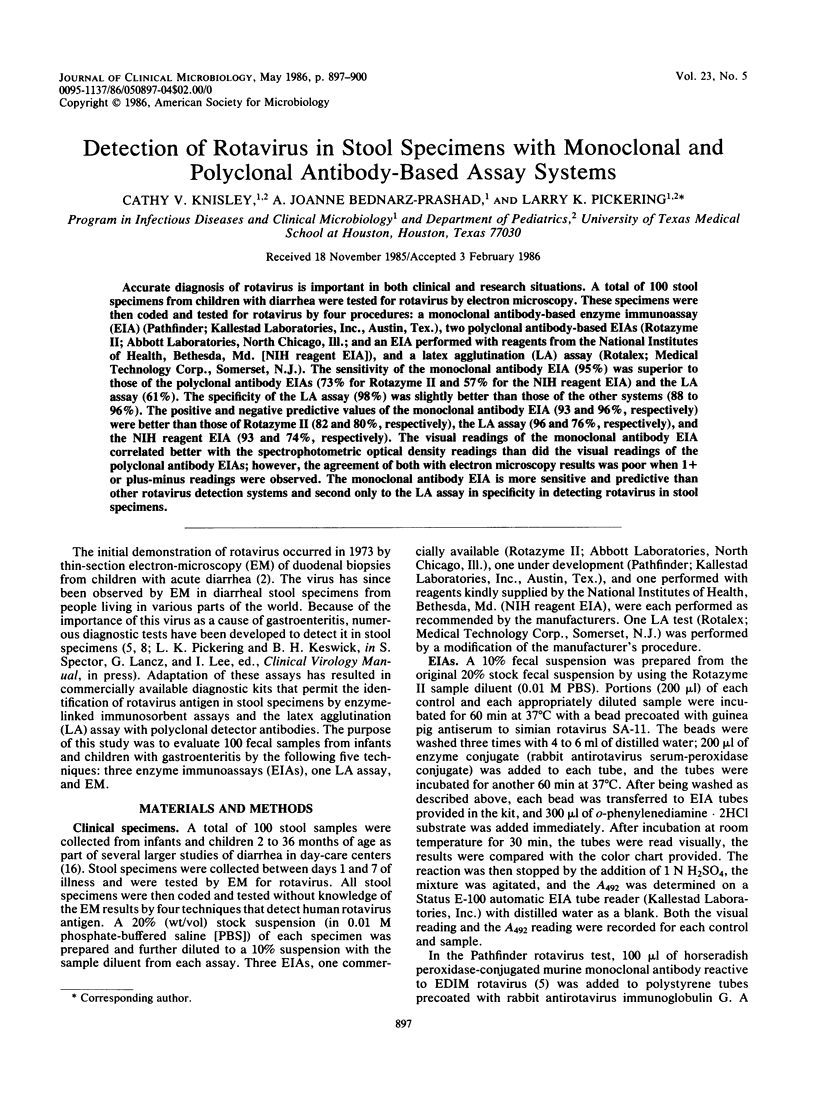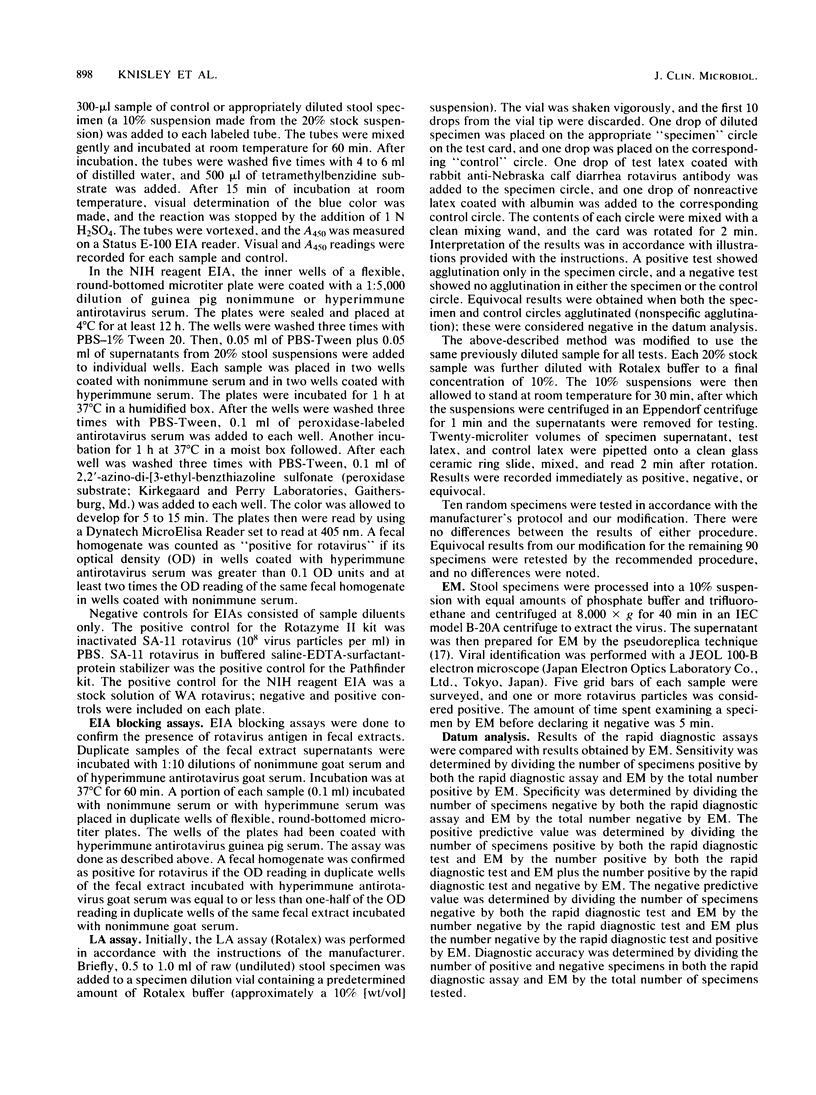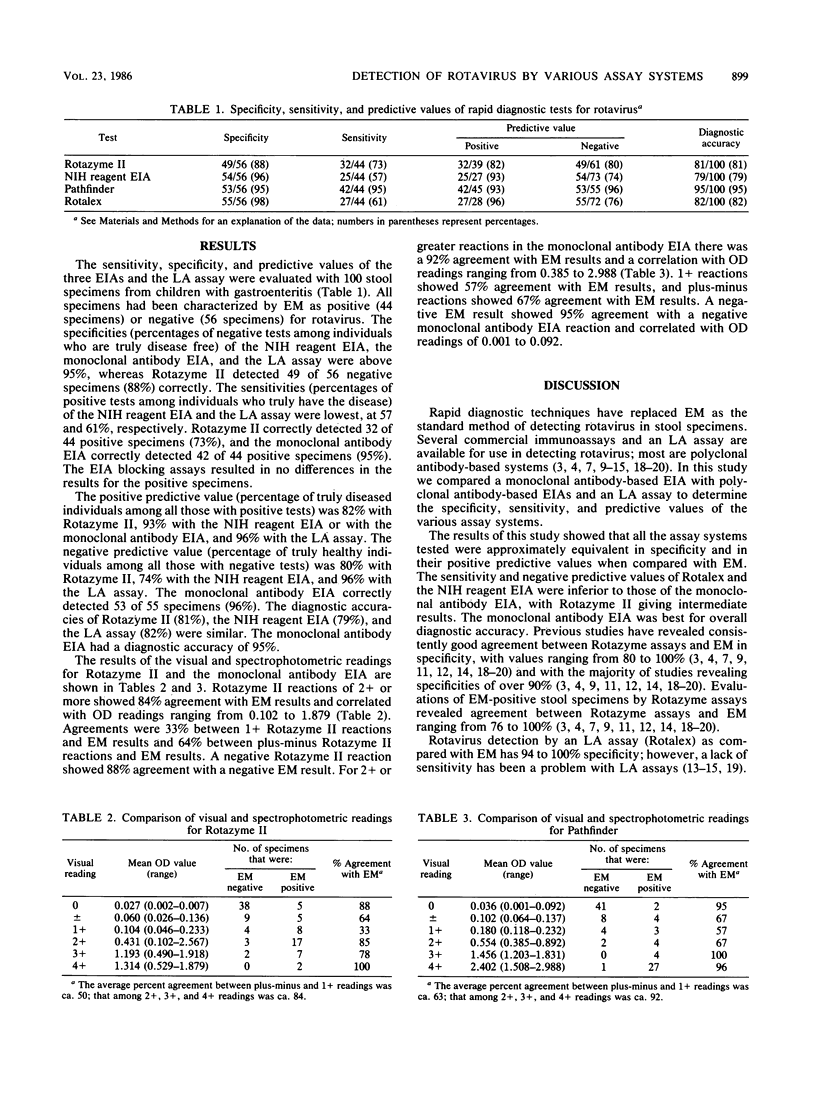Abstract
Accurate diagnosis of rotavirus is important in both clinical and research situations. A total of 100 stool specimens from children with diarrhea were tested for rotavirus by electron microscopy. These specimens were then coded and tested for rotavirus by four procedures: a monoclonal antibody-based enzyme immunoassay (EIA) (Pathfinder; Kallestad Laboratories, Inc., Austin, Tex.), two polyclonal antibody-based EIAs (Rotazyme II; Abbott Laboratories, North Chicago, Ill.; and an EIA performed with reagents from the National Institutes of Health, Bethesda, Md. [NIH reagent EIA]), and a latex agglutination (LA) assay (Rotalex; Medical Technology Corp., Somerset, N.J.). The sensitivity of the monoclonal antibody EIA (95%) was superior to those of the polyclonal antibody EIAs (73% for Rotazyme II and 57% for the NIH reagent EIA) and the LA assay (61%). The specificity of the LA assay (98%) was slightly better than those of the other systems (88 to 96%). The positive and negative predictive values of the monoclonal antibody EIA (93 and 96%, respectively) were better than those of Rotazyme II (82 and 80%, respectively), the LA assay (96 and 76%, respectively), and the NIH reagent EIA (93 and 74%, respectively). The visual readings of the monoclonal antibody EIA correlated better with the spectrophotometric optical density readings than did the visual readings of the polyclonal antibody EIAs; however, the agreement of both with electron microscopy results was poor when 1+ or plus-minus readings were observed. The monoclonal antibody EIA is more sensitive and predictive than other rotavirus detection systems and second only to the LA assay in specificity in detecting rotavirus in stool specimens.
Full text
PDF



Selected References
These references are in PubMed. This may not be the complete list of references from this article.
- Beards G. M., Campbell A. D., Cottrell N. R., Peiris J. S., Rees N., Sanders R. C., Shirley J. A., Wood H. C., Flewett T. H. Enzyme-linked immunosorbent assays based on polyclonal and monoclonal antibodies for rotavirus detection. J Clin Microbiol. 1984 Feb;19(2):248–254. doi: 10.1128/jcm.19.2.248-254.1984. [DOI] [PMC free article] [PubMed] [Google Scholar]
- Bishop R. F., Davidson G. P., Holmes I. H., Ruck B. J. Virus particles in epithelial cells of duodenal mucosa from children with acute non-bacterial gastroenteritis. Lancet. 1973 Dec 8;2(7841):1281–1283. doi: 10.1016/s0140-6736(73)92867-5. [DOI] [PubMed] [Google Scholar]
- Chernesky M., Castriciano S., Mahony J., DeLong D. Examination of the Rotazyme II enzyme immunoassay for the diagnosis of rotavirus gastroenteritis. J Clin Microbiol. 1985 Sep;22(3):462–464. doi: 10.1128/jcm.22.3.462-464.1985. [DOI] [PMC free article] [PubMed] [Google Scholar]
- Cheung E. Y., Hnatko S. I., Gunning H., Wilson J. Comparison of Rotazyme and direct electron microscopy for detection of rotavirus in human stools. J Clin Microbiol. 1982 Sep;16(3):562–563. doi: 10.1128/jcm.16.3.562-563.1982. [DOI] [PMC free article] [PubMed] [Google Scholar]
- Cukor G., Blacklow N. R. Human viral gastroenteritis. Microbiol Rev. 1984 Jun;48(2):157–179. doi: 10.1128/mr.48.2.157-179.1984. [DOI] [PMC free article] [PubMed] [Google Scholar]
- Cukor G., Perron D. M., Hudson R., Blacklow N. R. Detection of rotavirus in human stools by using monoclonal antibody. J Clin Microbiol. 1984 Jun;19(6):888–892. doi: 10.1128/jcm.19.6.888-892.1984. [DOI] [PMC free article] [PubMed] [Google Scholar]
- Dolan K. T., Twist E. M., Horton-Slight P., Forrer C., Bell L. M., Jr, Plotkin S. A., Clark H. F. Epidemiology of rotavirus electropherotypes determined by a simplified diagnostic technique with RNA analysis. J Clin Microbiol. 1985 May;21(5):753–758. doi: 10.1128/jcm.21.5.753-758.1985. [DOI] [PMC free article] [PubMed] [Google Scholar]
- Estes M. K., Palmer E. L., Obijeski J. F. Rotaviruses: a review. Curr Top Microbiol Immunol. 1983;105:123–184. doi: 10.1007/978-3-642-69159-1_3. [DOI] [PubMed] [Google Scholar]
- Hammond G. W., Ahluwalia G. S., Barker F. G., Horsman G., Hazelton P. R. Comparison of direct and indirect enzyme immunoassays with direct ultracentrifugation before electron microscopy for detection of rotaviruses. J Clin Microbiol. 1982 Jul;16(1):53–59. doi: 10.1128/jcm.16.1.53-59.1982. [DOI] [PMC free article] [PubMed] [Google Scholar]
- Hammond G. W., Ahluwalia G. S., Hazelton P. R. Detection of human rotaviruses in fecal specimens by a commercial latex-agglutination test. J Infect Dis. 1984 Jun;149(6):1021–1021. doi: 10.1093/infdis/149.6.1021. [DOI] [PubMed] [Google Scholar]
- Keswick B. H., Hejkal T. W., DuPont H. L., Pickering L. K. Evaluation of a commercial enzyme immunoassay kit for rotavirus detection. Diagn Microbiol Infect Dis. 1983 Jun;1(2):111–115. doi: 10.1016/0732-8893(83)90040-8. [DOI] [PubMed] [Google Scholar]
- Miotti P. G., Eiden J., Yolken R. H. Comparative efficiency of commercial immunoassays for the diagnosis of rotavirus gastroenteritis during the course of infection. J Clin Microbiol. 1985 Nov;22(5):693–698. doi: 10.1128/jcm.22.5.693-698.1985. [DOI] [PMC free article] [PubMed] [Google Scholar]
- Moosai R. B., Alcock R., Bell T. M., Laidler F. R., Peiris J. S., Wyn-Jones A. P., Madeley C. R. Detection of rotavirus by a latex agglutination test, Rotalex: comparison with electron microscopy, immunofluorescence, polyacrylamide gel electrophoresis, and enzyme linked immunosorbent assay. J Clin Pathol. 1985 Jun;38(6):694–700. doi: 10.1136/jcp.38.6.694. [DOI] [PMC free article] [PubMed] [Google Scholar]
- Morinet F., Ferchal F., Colimon R., Pérol Y. Comparison of six methods for detecting human rotavirus in stools. Eur J Clin Microbiol. 1984 Apr;3(2):136–140. doi: 10.1007/BF02014331. [DOI] [PMC free article] [PubMed] [Google Scholar]
- Pai C. H., Shahrabadi M. S., Ince B. Rapid diagnosis of rotavirus gastroenteritis by a commercial latex agglutination test. J Clin Microbiol. 1985 Nov;22(5):846–850. doi: 10.1128/jcm.22.5.846-850.1985. [DOI] [PMC free article] [PubMed] [Google Scholar]
- Pickering L. K., Evans D. G., DuPont H. L., Vollet J. J., 3rd, Evans D. J., Jr Diarrhea caused by Shigella, rotavirus, and Giardia in day-care centers: prospective study. J Pediatr. 1981 Jul;99(1):51–56. doi: 10.1016/s0022-3476(81)80956-0. [DOI] [PubMed] [Google Scholar]
- Portnoy B. L., Conklin R. H., Menn M., Olarte J., DuPont H. L. Reliable identification of reovirus-like agent in diarrheal stools. J Lab Clin Med. 1977 Mar;89(3):560–563. [PubMed] [Google Scholar]
- Rubenstein A. S., Miller M. F. Comparison of an enzyme immunoassay with electron microscopic procedures for detecting rotavirus. J Clin Microbiol. 1982 May;15(5):938–944. doi: 10.1128/jcm.15.5.938-944.1982. [DOI] [PMC free article] [PubMed] [Google Scholar]
- Sambourg M., Goudeau A., Courant C., Pinon G., Denis F. Direct appraisal of latex agglutination testing, a convenient alternative to enzyme immunoassay for the detection of rotavirus in childhood gastroenteritis, by comparison of two enzyme immunoassays and two latex tests. J Clin Microbiol. 1985 Apr;21(4):622–625. doi: 10.1128/jcm.21.4.622-625.1985. [DOI] [PMC free article] [PubMed] [Google Scholar]
- Yolken R. H., Leister F. J. Evaluation of enzyme immunoassays for the detection of human rotavirus. J Infect Dis. 1981 Oct;144(4):379–379. doi: 10.1093/infdis/144.4.379. [DOI] [PubMed] [Google Scholar]


